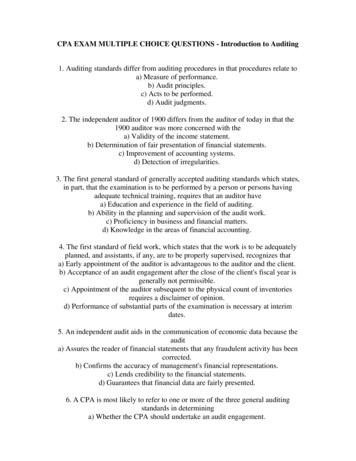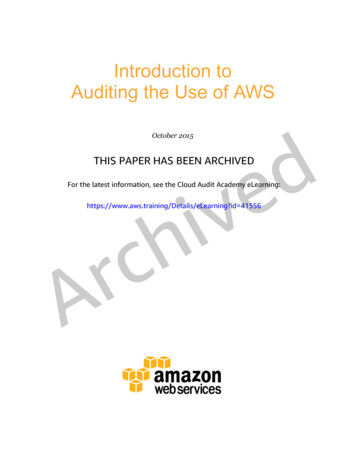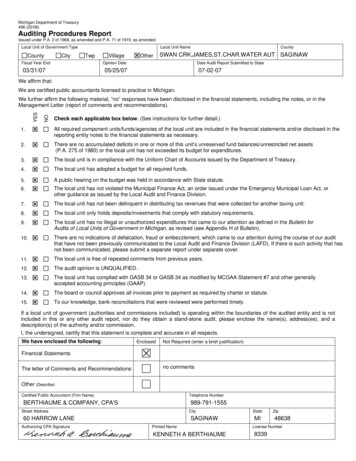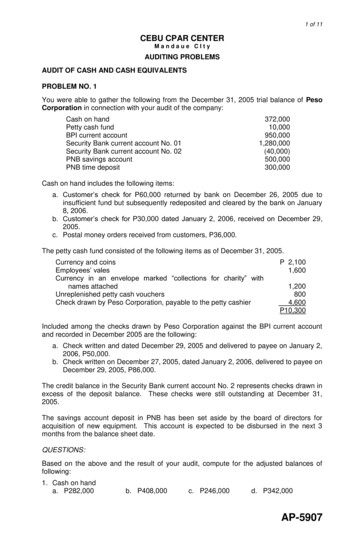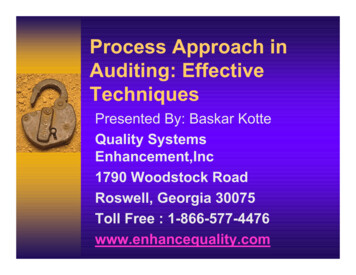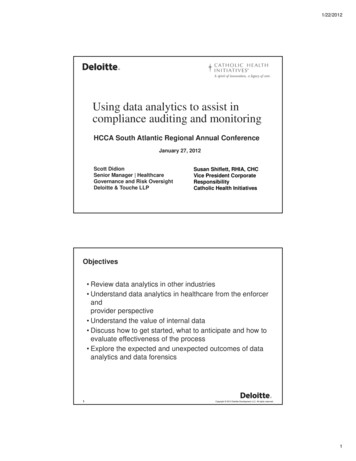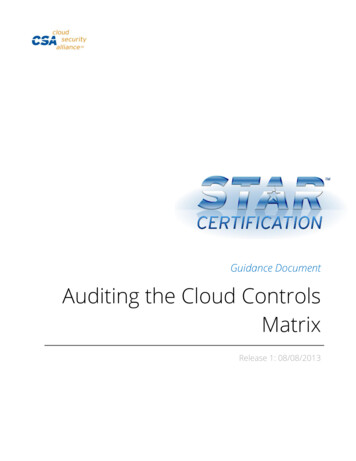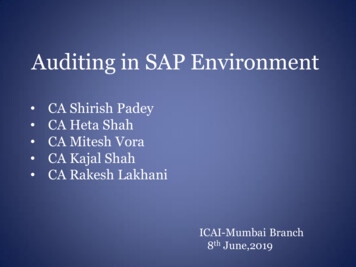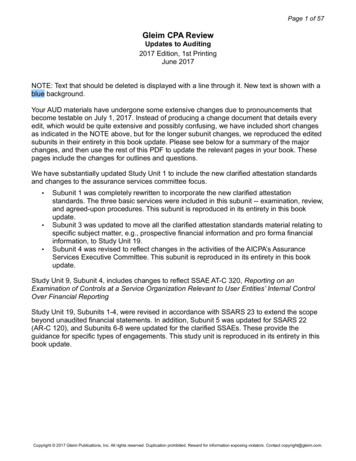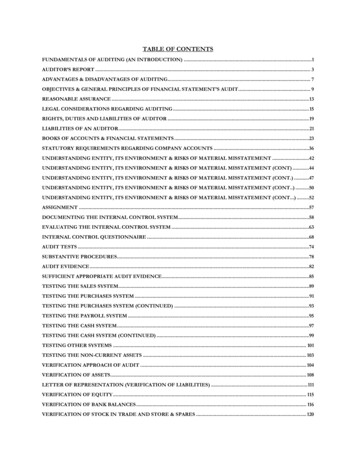
Transcription
TABLE OF CONTENTSFUNDAMENTALS OF AUDITING (AN INTRODUCTION) . 1AUDITOR’S REPORT . 3ADVANTAGES & DISADVANTAGES OF AUDITING. 7OBJECTIVES & GENERAL PRINCIPLES OF FINANCIAL STATEMENT'S AUDIT . 9REASONABLE ASSURANCE . 13LEGAL CONSIDERATIONS REGARDING AUDITING . 15RIGHTS, DUTIES AND LIABILITIES OF AUDITOR . 19LIABILITIES OF AN AUDITOR . 21BOOKS OF ACCOUNTS & FINANCIAL STATEMENTS .23STATUTORY REQUIREMENTS REGARDING COMPANY ACCOUNTS .36UNDERSTANDING ENTITY, ITS ENVIRONMENT & RISKS OF MATERIAL MISSTATEMENT .42UNDERSTANDING ENTITY, ITS ENVIRONMENT & RISKS OF MATERIAL MISSTATEMENT (CONT) .44UNDERSTANDING ENTITY, ITS ENVIRONMENT & RISKS OF MATERIAL MISSTATEMENT (CONT.) .47UNDERSTANDING ENTITY, ITS ENVIRONMENT & RISKS OF MATERIAL MISSTATEMENT (CONT.) .50UNDERSTANDING ENTITY, ITS ENVIRONMENT & RISKS OF MATERIAL MISSTATEMENT (CONT.) .52ASSIGNMENT .57DOCUMENTING THE INTERNAL CONTROL SYSTEM .58EVALUATING THE INTERNAL CONTROL SYSTEM .63INTERNAL CONTROL QUESTIONNAIRE .68AUDIT TESTS .74SUBSTANTIVE PROCEDURES .78AUDIT EVIDENCE .82SUFFICIENT APPROPRIATE AUDIT EVIDENCE .85TESTING THE SALES SYSTEM.89TESTING THE PURCHASES SYSTEM . 91TESTING THE PURCHASES SYSTEM (CONTINUED) .93TESTING THE PAYROLL SYSTEM .95TESTING THE CASH SYSTEM .97TESTING THE CASH SYSTEM (CONTINUED) .99TESTING OTHER SYSTEMS . 101TESTING THE NON-CURRENT ASSETS . 103VERIFICATION APPROACH OF AUDIT . 104VERIFICATION OF ASSETS. 108LETTER OF REPRESENTATION (VERIFICATION OF LIABILITIES) . 111VERIFICATION OF EQUITY . 115VERIFICATION OF BANK BALANCES . 116VERIFICATION OF STOCK IN TRADE AND STORE & SPARES . 120
AUDIT SAMPLING . 122STATISTICAL SAMPLING . 125INTERNAL AUDITING . 128AUDIT PLANNING . 131PLANNING AN AUDIT OF FINANCIAL STATEMENTS . 134AUDIT PLANNING (ESTABLISHING OVERALL AUDIT STRATEGY) . 137AUDITOR’S REPORT ON A COMPLETE SET OF GENERAL PURPOSE FINANCIAL STATEMENTS . 140MODIFIED AUDITOR’S REPORT. 146
Fundamentals of Auditing –ACC 311VULesson 01FUNDAMENTALS OF AUDITINGAN INTRODUCTIONWhat is an Audit?Audit is an independent examination of financial statements of an entity that enables an auditor to expressan opinion whether the financial statements are prepared (in all material respects) in accordance with anidentified and acceptable financial reporting framework (e.g. international or local accounting standards andnational legislations)This view of audit is presented by ISA 200 Objective and General Principles Governing an Audit of FinancialStatements.The phrases used; “to express the auditor’s opinion” means that the financial statements give a true and fairview or have been presented fairly in all material respects.True and fair presentation means that the financial statement are prepared and presented in accordance withthe requirements of the applicable International Financial Reporting Standards (IFRS) and localpronouncements/legislations.What we can understand as the essential features of an audit from the above definition and explanation areas under: An auditor involves in examination of financial statements, the auditor is not responsible for thepreparation of the financial statements. The end result of an audit is an opinion to assist the user of the financial statements. Auditingtherefore relies heavily on professional judgment, not merely on the facts. The auditor’s opinion makes reference to “true and fair” or “fair presentations” but “true and fair”is again a matter of judgment. It is not precisely defined for the auditor. In order to make the user of the auditor’s report able to feel confident in relying on such report, theauditor should be independent of the entity. Independent essentially means that the auditor has nosignificant personal interest in the entity. This allows an objective, professional view to be taken.You will note that this is a wide concept of an audit which can be applied to any entity, not just to limitedcompanies. However, in this course, we are concerned primarily with audits of limited companies (oftenknown as statutory or external audits). Any other audit applications will be clearly indicated for you in thetext.Why is there a need for an audit?The problem that has always existed at the time when the manager reports to the owners is that: whetherthe owners will believe the report or not? This is because the reports may:a. Contain errorsb. Not disclose fraudc. Be inadvertently misleadingd. Be deliberately misleadinge. Fail to disclose relevant informationf. Fail to conform to regulationsThe solution to this problem of credibility in reports and accounts lies in appointing an independent personcalled an auditor to examine the financial statements and report on his findings.A further point is that modern companies can be very large with multi-national activities. The preparationof the accounts of such groups is a very complex operation involving the bringing together andsummarizing of accounts of subsidiaries with differing conventions, legal systems and accounting andcontrol systems. The examination of such accounts by independent experts who are trained in theassessment of financial information is of benefit to those who control and operate such organizations aswell as to owners and outsiders.Many financial statements must conform to statutory or other requirements. The most notable is that allcompany accounts have to conform to the requirements of the Companies Ordinance 1984 but many other Copyright Virtual University of Pakistan1
Fundamentals of Auditing –ACC 311VUbodies (like: Charities, Building Societies, Financial Services business etc) have detailed accountingrequirements as required by the relevant legislations. In addition all accounts should conform to therequirements of International Financial Reporting Standards (IFRSs).It is essential that an audit of financial statements should be carried out to ensure that they conform to theserequirements.What is the distinction between auditing and accounting?Relationship between auditing and accountingAuditing and accounting are closely connected but both are separate activities. The directors of a companyare responsible for establishing books of accounts that will accurately record financial information and thatare used for preparing the annual financial statements. It is similarly the responsibility of the directors toadopt consistent and appropriate accounting policies in order to prepare and present the financialstatements. The financial statements have to comply with national legislative requirements and InternationalFinancial Reporting Standards (IFRSs).Accounting is the process of recording, classifying, summarizing and reporting financial information in alogical/systematic manner for the purpose of decision making. To provide relevant & reliable information,accountants must have a thorough understanding of the principles and rules that provide the basis forpreparing the financial statements.In auditing the financial statements, the concern is with determining whether the presented financialstatements properly (true and fair) reflect the financial information that occurred during the accountingperiod. Since auditors are primarily concerned with the end result of this work i.e. do the financialstatements show a true and fair view? In order to arrive at their conclusion the auditors must have a deepknowledge and understanding of accounting (including applicable accounting standards) and in practice, thedirectors will consult with the auditors as to appropriate accounting policies to follow.Many financial statement users and members of the general public confuse auditing with accounting. Theconfusion results because most auditing is concerned with accounting information, and many auditors haveconsiderable expertise in accounting matters. The confusion is increased by giving the title “CharteredAccountant” to individuals performing a major portion of the audit function.Who can be an auditor?For appointment as auditor of:a)a Public Company orb)a Private Company which is a subsidiary of a Public Company.c)a Private Company having paid up capital of three million rupees or more.The person must be a Chartered Accountant within the meaning of the Chartered Accountants Ordinance,1961.For listed companies an auditor must have a satisfactory QCR (quality control review) rating issued byICAP. Copyright Virtual University of Pakistan2
Fundamentals of Auditing –ACC 311VULesson 02Fundamentals of AuditingAuditing – An IntroductionWhat is an auditor’s report?The primary aim of an audit is to enable the auditor to say “these accounts show a true and fair view” or, ofcourse, to say that “they do not show a true and fair view”.At the end of his audit, when he has examined the entity, its record, and its financial statements, the auditorproduces a report addressed to the owners/stake holders in which he expresses his opinion of the truth andfairness, and sometimes other aspects, of the financial statements.Standard format of Auditor’s Report as per the Companies Ordinance 1984:FORM 35AAUDITORS’ REPORTWe have audited the annexed balance sheet of COMPANY NAME as at THE DATE and the related profitand loss account, cash flow statement and statement of changed in equity together with the notes
Management’s Responsibility for the Financial Statements Management is responsible for the preparation and fair presentation of these financial statements in accordance with International Financial Reporting Standards. This responsibility includes: designing,
